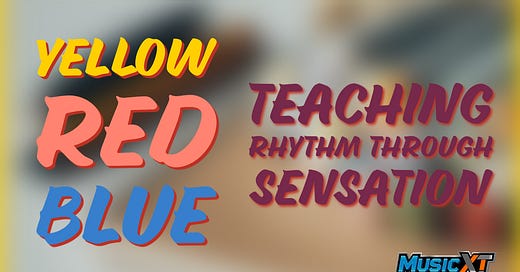What is rhythm? Seriously. It has something to do with time… something to do with division and sub divisions… but what is it? What makes something “rhythmic?” I might argue that the defining characteristic of rhythm is SENSATION. This means that rhythm primarily is identifiable by the FEELING of rhythm. Any effort to acquire rhythmic skills should include this SENSATION into its vocabulary. (This is part of my reasoning for abandoning numbers BTW… more on that later). In this post I’ll share an extended DEMO and instructional video on how I start to introduce rhythmic literacy, identification, and improvisation to children as young as Kindergarten. But first…
Housekeeping:
Make sure you’re upgraded to the TEAMM Subscription so you can attend this meeting! I’ll go IN DEPTH on this idea and give all sorts of philosophical and practical thoughts on the utility of numbers in a music curriculum. The TEAMM is growing each and every week and I’m glad to welcome new members all the time! Aside from access to the substantial archive of posts you get tons of content reserved for TEAMM only, as well as individualized coaching from YOURS TRULY and invitations to the workshops/meetings every month! It’s the best $10 you’ll ever spend. (Many of the TEAMM members get their admin to pay for it…)
From the Archive:
Literacy and Movement
This was an EXTENDED conversation about how important literacy is and how MOVEMENT can be used to build strong literacy skills in Dalcroze classrooms. Enjoy!
One of my mantras is “FEELING FIRST.” This is my way of saying that all musical concepts should be experienced through feeling before they are explained or analyzed. In a context in which the children are primarily receiving instruction through my class, it is powerful for them to connect to musical concepts through their own natural instinct before making those ideas conscious. In a context in which the students are receiving musical instruction from an instrumental or choral teacher and my class is only PART of their portfolio of instruction, this makes Eurhythmics as valuable asset and a missing component to well rounded education.
Personally, I like to use natural speech, accompanied by gesture, as the first interaction that the students have with rhythmic figures. This means that they are NOT taught hard-and-fast names for the notes or given values to remember. They are exposed to the words and sensations simultaneously which encourages them to associate the FEELING of each rhythmic figure with its sound. Then they are to associate the FEELING and SOUND with a visual notation system.
You can see how these concepts are built out in this extended demo video!






